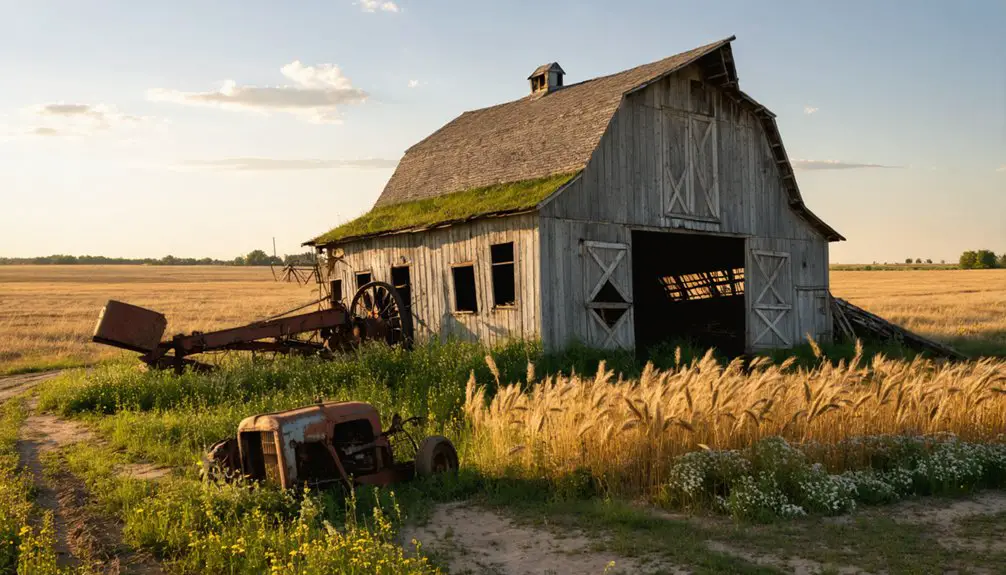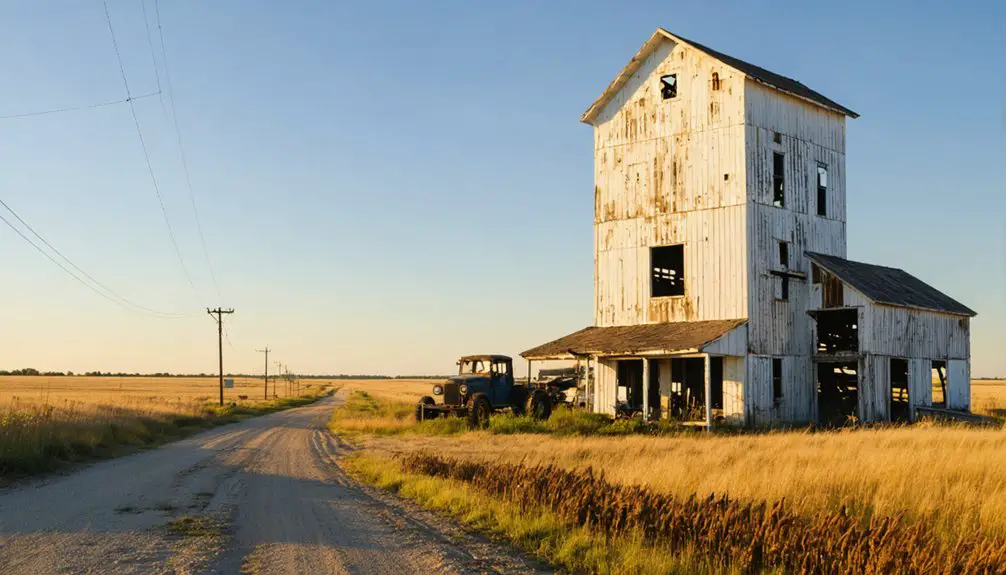You’ll find Dogtooth, North Dakota at 46.3939°N, -101.347°W in Grant County, where distinctive dog molar-shaped buttes once guided travelers along the Deadwood-Bismarck Trail. The town emerged as a stagecoach station in 1877, later gaining a post office in 1900. When the post office moved to rival town Raleigh in 1920, Dogtooth’s population declined until it became a ghost town. Today, only the namesake buttes and local landmarks preserve its frontier legacy.
Key Takeaways
- Dogtooth was a North Dakota settlement named for distinctive butte formations resembling dog molars that served as landmarks for travelers.
- The town developed along the historic Deadwood-Bismarck Trail, which operated stagecoach services from 1877 with stations every 20 miles.
- A post office established in 1900 made Dogtooth a community hub until its relocation to Raleigh in 1920.
- The town’s decline began when businesses and residents migrated to Raleigh for better opportunities along the Milwaukee Railroad line.
- Today, Dogtooth exists as a ghost town with no remaining buildings, though its legacy lives on through local landmarks and business names.
Origins of the Dogtooth Name
While many frontier towns derived their names from settlers or cultural influences, Dogtooth, North Dakota acquired its distinctive name from the natural landscape that surrounded it.
You’ll find the geographical significance of the name in the distinctive buttes visible from the town site, which resembled the molars on a dog’s lower jaw. These tooth-like formations served as essential navigational markers for early settlers, establishing a strong community identity tied to the land. The town served as a critical station and stopover along the historic Deadwood-Bismarck Trail.
Rising from the prairie like ancient fangs, Dogtooth’s namesake buttes guided settlers and shaped the town’s enduring connection to the landscape.
You can trace this naming convention through official records, including postal documents and local newspapers, which consistently confirm the connection between the town’s name and these unique rock formations. The name exemplifies the practical approach to place-naming common throughout North Dakota’s settlement history.
For researchers seeking additional information about Dogtooth’s history, it’s important to note that this location appears as a disambiguation page entry in various historical databases.
Early Settlement and Railroad Years
When the Deadwood-Bismarck Trail emerged as a vital transportation route in 1876, Dogtooth established itself as a strategic station along this bustling pathway.
You’ll find this pioneering settlement’s history marked by dramatic changes as railroad competition transformed the region. The Northern Pacific’s arrival in 1880 spelled trouble for Dogtooth’s prominence, and by 1909, the Milwaukee Railroad’s development of nearby Raleigh sealed its fate.
- Homesteaders flocked to the region between 1879-1886, drawn by fertile land
- Scandinavian and Germanic settlers shaped the area’s cultural identity
- The town occupied Section 11, township 133N, range 85W in Grant County
- Charles Leonard’s store and post office relocated to Raleigh in 1910
- Rail access proved decisive, as farmers needed efficient grain shipping options
Life Along the Deadwood-Bismarck Trail
You’d find the Deadwood-Bismarck Trail station operations running like clockwork in 1877, with three weekly stagecoaches transporting passengers, freight, and mail across the challenging 240-mile route.
Your journey would cost $23 and take nearly 40 hours, as the Concord coaches navigated difficult terrain with teams of horses changed regularly at stations along the way. The Northwest Express and Transportation Company operated 26 Concord coaches and freight wagons to meet the growing demand.
If you were among the surge of travelers heading to the Black Hills gold fields, you’d face limited accommodation options, as local hotels filled quickly with gold seekers and merchants making the frontier journey. Today, visitors can explore the trail’s history through informational markers that detail the route’s significance.
Trail Station Operations
As travelers made their way along the Deadwood-Bismarck trail in 1877, they’d encounter a network of strategically placed stagecoach stations every 20 miles.
These crucial outposts, including colorfully named stops like Dog Tooth and Grasshopper Pete, guaranteed stagecoach efficiency while maintaining horse welfare through regular team changes. The journey proved quite costly for passengers, with twenty-three dollars required for a one-way ticket.
The Northwest Express and Transportation Company managed twenty relay stations and two overnight stops across the 240-mile route, where you’d find:
- Fresh horse teams ready for exchange, with 4-6 horses per coach
- Brief rest periods for stretching and refreshments
- Important mail and supply transfer points
- Shelter from the harsh Dakota Territory elements
- Quick turnaround service supporting up to three daily stages
These stations formed the backbone of a transportation network that moved passengers, freight, and mail between Bismarck and the Black Hills. Passengers could make the entire journey in just 36 hours with daily service available.
Frontier Travel Conditions
Taking the Deadwood-Bismarck trail in 1877 meant enduring a grueling 36 to 40-hour journey across 240 miles of untamed Dakota Territory.
You’d pay $23 (about $700 today) to face frontier hardships in a cramped Concord stagecoach, bouncing over primitive roads through plains, hills, and treacherous river crossings.
Travel logistics involved stopping at relay stations every 20 miles to change horses, but you’d find no hotels or proper towns along the way.
These isolated outposts offered only basic shelter, water, and sometimes food for purchase.
You’d brave unpredictable weather, from scorching heat to bitter cold, while confined with other passengers and mail cargo.
The daily stage service operated year-round, requiring over 200 horse teams to maintain the essential transportation link between Bismarck and Deadwood.
The Post Office Era
The Dogtooth post office marked a pivotal chapter in the town’s history when it opened on March 20, 1900, under postmaster Robert Pearce.
You’d find this post office operations center serving as a crucial community hub, especially after the railway station’s closure in 1880. The facility supported local commerce and connected settlers to regional trade networks during the early 1900s. Located in Grant County, the post office played a vital role in supporting the region’s development.
- The post office attracted new businesses, including a general store and blacksmith shop
- You could ship grain and goods regionally without long hauls to railheads
- Postal services enabled essential communication for frontier settlements
- The facility served as a gathering point for local trade and social activities
The post office’s eventual move to Raleigh in 1920 contributed significantly to Dogtooth’s decline.
Emergence of Rival Town Raleigh

While Dogtooth’s influence waned, Raleigh emerged as a strategically positioned coaling stop on the Milwaukee Road railroad’s branch line.
The railroad competition between towns intensified when Charles C. Leonard relocated his general store from Dogtooth to Raleigh, coinciding with the opening of Raleigh’s post office on October 1, 1910.
Just as North Carolina’s capital city Raleigh did in 1788, this new settlement began establishing itself as an important regional center. You’ll find Raleigh’s origins deeply rooted in the economic shift that followed the railroad’s expansion from McLaughlin, South Dakota. Named after Sir Walter Raleigh, the town attracted primarily German Russian settlers from near Strasburg in Emmons County. Much like the early North Carolina Legislature, the town faced political rivalries and disputes over its development.
Located in the northeast quarter of section 12, Township 133 north, Range 86 west, Raleigh’s establishment as a railway hub effectively sealed Dogtooth’s fate, leading to the closure of its post office and eventual decline.
Final Days and Population Decline
As Raleigh’s commercial success mounted, Dogtooth’s final chapter began to unfold in 1910. The shifting community dynamics started with Charles Leonard’s relocation of his store and post office to the rival town.
You’d have witnessed a steady exodus as residents sought better opportunities near the Milwaukee Railroad line, marking significant economic changes for both settlements.
- Post office closure dealt a devastating blow to local services
- Farmers abandoned the isolated location for easier rail access
- Business owners followed the population shift to Raleigh
- Schools and other institutions gradually shuttered
- Community functions ceased entirely by mid-century
The once-promising railroad station couldn’t survive the transportation realignments that favored other locations.
Today, you won’t find any remaining buildings at Dogtooth’s original site, as the ghost town stands as a reflection of the harsh realities of economic necessity.
Legacy in Modern Grant County

Despite vanishing from the physical landscape, Dogtooth’s influence endures throughout modern Grant County in various ways. You’ll find its cultural continuity most prominently in Raleigh, where The Dogtooth bar pays homage to the ghost town and its distinctive buttes.
The local identity remains strong through geographic references and business names that keep the town’s memory alive.
Though Dogtooth vanished from the map, its spirit lives on through local landmarks and businesses honoring its memory.
While no buildings remain at Dogtooth’s original site, its legacy shapes the region’s historical narrative. The movement of the post office and store to nearby Raleigh symbolizes the area’s evolution, driven by railroad development.
Today, the dogtooth-shaped buttes still define the landscape, attracting history enthusiasts and serving as natural monuments that remind visitors of the settlement patterns that shaped Grant County’s development.
Historical Significance in North Dakota
You’ll find Dogtooth’s historical significance deeply rooted in North Dakota’s early railroad settlement patterns, where its shift from a trail station to a ghost town mirrors the fate of many frontier communities.
The town’s cultural landscape was shaped by Scandinavian immigrants who settled in the region, contributing to the area’s agricultural development before relocating to nearby Raleigh.
When the Milwaukee Railroad bypassed Dogtooth in favor of Raleigh, you can trace how the resulting town relocation pattern permanently altered Grant County’s demographic distribution and economic focus.
Early Railroad Settlement Legacy
When stagecoach service began between Bismarck and Deadwood in 1876, Dogtooth emerged as the third station along this essential transportation route, positioned approximately 20 miles from neighboring stops.
The settlement’s fortunes shifted dramatically with railroad migration patterns, as the Northern Pacific Railroad’s arrival in 1880 marked the end of stagecoach routes but didn’t immediately doom the town.
You’ll find that Dogtooth adapted, maintaining its community through 1900 when it established a post office.
- Served as crucial rest stop and horse exchange point for early travelers
- Connected the significant Deadwood-Bismarck transportation corridor
- Survived initial railroad changes but faced competition from new rail towns
- Lost population to nearby Raleigh after Milwaukee Railroad’s 1910 arrival
- Exemplified the broader pattern of transportation-driven settlement changes in western North Dakota
Throughout North Dakota’s formative years, Scandinavian immigrants transformed the state’s demographic landscape, with their influence peaking between 1892 and 1905 as they comprised nearly half of all newcomers.
You’ll find their impact was particularly strong in agriculture, with Norwegian settlers alone owning 20% of the state’s farmland by 1914.
Their Lutheran heritage shaped community development as they established churches, schools, and hospitals across the region.
Unlike some immigrant groups, they quickly adopted English and embraced American civic life while maintaining their cultural traditions.
You can trace their lasting influence through their rapid integration into local politics and governance by 1920.
Their agricultural expertise and high literacy rates helped them thrive, as they leveraged land opportunities that weren’t available in their homeland, particularly for Norway’s younger sons who couldn’t inherit family farms.
Town Relocation Patterns
Major infrastructure projects in North Dakota’s history have greatly reshaped its communities, most remarkably through the construction of Garrison Dam in the mid-20th century.
You’ll find that relocation motivations often stemmed from both planned developments and economic necessities, forcing towns to adapt or face abandonment. Town viability frequently depended on proximity to transportation routes, with many communities relocating to follow railroad lines or highway systems.
- Communities like Old Sanish and Elbowoods relocated to higher ground when Garrison Dam submerged their original sites.
- Railroad placement influenced town movements, as seen in Williamsport’s relocation to Hazelton.
- Agricultural mechanization and economic downturns triggered mass migrations from farming communities.
- Loss of county seat status prompted administrative and commercial shifts.
- Transportation route changes, including Interstate 94’s development, led to strategic community relocations.
Physical Geography and Location Details
The rugged buttes of western North Dakota cradle the ghost town of Dogtooth at 46.3939°N, -101.347°W in Grant County.
You’ll find this historic site in Section 11 of Township 133 North, Range 85 West, where distinctive topographical features shaped like dog molars gave the settlement its name.
The semi-arid landscape surrounding Dogtooth reflects the harsh regional climate typical of the northern plains.
The unforgiving northern plains shape Dogtooth’s arid terrain, where nature’s harsh conditions dominate the landscape.
You’re in an area where grassland prairies meet rolling buttes, creating an environment that early settlers adapted to for farming.
The town’s location near the Deadwood-Bismarck Trail proved strategic, while its proximity to Raleigh, just two miles east, connected it to emerging settlements.
Modern access comes via SR 23, running half a mile north of the ghost town’s remains.
Frequently Asked Questions
Were There Any Notable Crimes or Incidents in Dogtooth’s Short History?
You won’t find any documented crimes or unsolved mysteries in the records – even local legends are surprisingly quiet, with no tales of lawlessness during the town’s brief four-year railroad station existence.
What Was the Highest Recorded Population of Dogtooth?
You’ll find the town’s highest recorded population reached about 20 people, with limited population growth due to its brief historical significance before nearby Raleigh drew residents away by 1911.
Did Any Native American Tribes Live in the Area Before Settlement?
You’ll find rich Native American history in this area, where Dakota, Mandan, Hidatsa, and Arikara tribes established their presence, hunting bison and farming along riverways for thousands of years.
What Happened to the Original Buildings When Residents Left?
You’ll find no historical preservation occurred – the abandoned structures were either dismantled and moved to Raleigh, fell into natural decay, or were demolished, leaving no original buildings standing by late 1900s.
Were There Any Schools or Churches Established in Dogtooth?
Like footprints in shifting sand, you won’t find traces of schools or churches in historical records. Your search reveals they weren’t established there, with residents likely attending institutions in nearby Raleigh instead.
References
- https://en.wikipedia.org/wiki/Dogtooth
- https://www.loquis.com/en/loquis/6508779/Dogtooth+North+Dakota
- https://northernsentry.com/2025/06/26/north-dakota-ghost-towns/
- https://us1033.com/a-haunting-look-at-some-real-life-north-dakota-ghost-towns/
- https://ghostsofnorthdakota892857007.wordpress.com/2016/01/29/raleigh-north-dakota/
- https://www.routeyou.com/en-us/location/view/51640636?toptext=8007382
- https://commons.und.edu/cgi/viewcontent.cgi?filename=9&article=1000&context=oers&type=additional
- https://www.history.nd.gov/ndhistory/settlement.html
- https://www.ndstudies.gov/gr4/early-settlement-north-dakota/part-1-early-settlement-north-dakota/section-8-river-and-overland
- https://commons.und.edu/context/oers/article/1000/viewcontent/History_of_ND_FinalPDF.pdf



